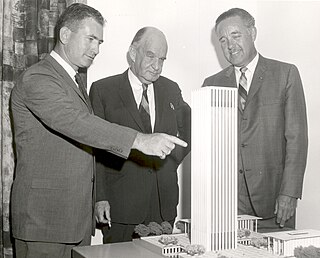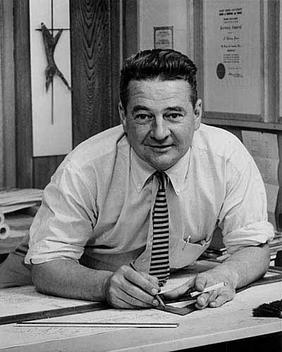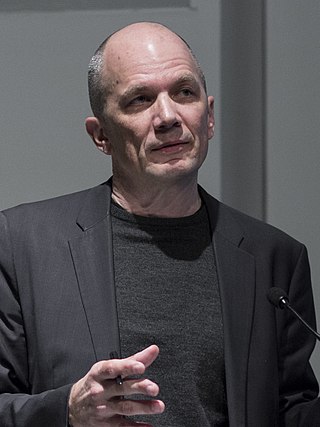
Frank Owen Gehry is a Canadian-born American architect and designer. A number of his buildings, including his private residence in Santa Monica, California, have become world-renowned attractions.

Edward Durell Stone was an American architect known for the formal, highly decorative buildings he designed in the 1950s and 1960s. His works include the Museum of Modern Art, in New York City, the Museo de Arte de Ponce in Ponce, Puerto Rico, the United States Embassy in New Delhi, India, The Keller Center at the University of Chicago, and the John F. Kennedy Center for the Performing Arts in Washington, D.C and the Ecotarium, formerly known as the New England Science Center in Worcester, Massachusetts.

Moshe Safdie is an architect, urban planner, educator, theorist, and author. He is known for incorporating principles of socially responsible design throughout his six-decade career. His projects include cultural, educational, and civic institutions; neighborhoods and public parks; housing; mixed-use urban centers; airports; and master plans for existing communities and entirely new cities in the Americas, the Middle East, and Asia. Safdie is most identified with designing Marina Bay Sands and Jewel Changi Airport, as well as his debut project Habitat 67, which was originally conceived as his thesis at McGill University. He holds legal citizenship in Israel, Canada, and the United States.

Thom Mayne is an American architect. He is based in Los Angeles. In 1972, Mayne helped found the Southern California Institute of Architecture (SCI-Arc), where he is a trustee and the coordinator of the Design of Cities postgraduate program. Since then he has held teaching positions at SCI-Arc, the California State Polytechnic University, Pomona and the University of California, Los Angeles (UCLA). He is principal of Morphosis Architects, an architectural firm based in Culver City, California and New York City, New York. Mayne received the Pritzker Architecture Prize in March 2005.

Archibald Quincy Jones was a Los Angeles–based architect and educator known for innovative buildings in the modernist style and for urban planning that pioneered the use of greenbelts and green design.
Diamond Schmitt Architects is a Canadian architectural firm founded in 1975. It is headquartered in Toronto, Ontario. The firm was founded by architects Jack Diamond and Donald Schmitt.
Coop Himmelb(l)au is an architecture, urban planning, design and art firm founded in 1968 by Wolf D. Prix, Helmut Swiczinsky and Michael Holzer in Vienna, Austria.
Bruce Bunji Kuwabara, is a Canadian architect and a founding partner of the firm KPMB Architects. He is an invested Officer of the Order of Canada and recipient of the RAIC Gold Medal. He is Board Chair of the Canadian Centre for Architecture in Montreal.

Grant Mudford, is an Australian photographer.

Randall Paul Stout was a Los Angeles, California based architect.

An Te Liu is a Taiwanese-Canadian artist based in Toronto. Liu has become well known for his predominantly sculptural practice that involves a creative and insightful use of everyday found objects that are reconfigured into often playful yet critical commentaries on the ideals of modernism.

Koning Eizenberg Architecture (KEA) is an architecture firm located in Santa Monica, California established in 1981. The firm is recognized for a range of project types including: adaptive reuse of historic buildings, educational facilities, community places, and housing. Principals Hank Koning, Julie Eizenberg, Brian Lane, and Nathan Bishop work collaboratively with developers, cities and not-for-profit clients. Their work has been published extensively both in the US and abroad, and has earned over 200 awards for design, sustainability and historic preservation.
KPMB is a Canadian architecture firm founded by Bruce Kuwabara, Thomas Payne, Marianne McKenna, and Shirley Blumberg, in 1987. It is headquartered in Toronto, where the majority of their work is found. Aside from designing buildings, the firm also works in interior design. KPMB Architects was officially renamed from Kuwabara Payne McKenna Blumberg Architects to KPMB Architects on February 12, 2013.

Michael Maltzan is the principal architect at Michael Maltzan Architecture (MMA), a Los Angeles–based architecture firm. He received a Master of Architecture degree from Harvard University and both a Bachelor of Architecture degree and a Bachelor of Fine Arts degree from the Rhode Island School of Design. Maltzan was selected as a Fellow of the American Institute of Architects in 2007.

Kevin Daly Architects (KDA) is Kevin Daly's architecture firm in Los Angeles, California. It was founded in 1990 as Daly Genik. Daly has taught architecture and is a fellow at the American Institute of Architects (FAIA).
Hodgetts + Fung, also known as HplusF, is an interdisciplinary design studio based in Culver City, California specializing in architectural design, advanced material fabrication, historical restorations, and exhibition design and is led by principals Craig Hodgetts and Hsinming Fung.
Shirley Blumberg is a Canadian architect. She is a founding partner of KPMB Architects in Toronto, a Canadian practice. In 2013, Blumberg was invested as a Member of the Order of Canada "for her contributions to architecture and for her commitment to creating spaces that foster a sense of community." Notable projects include the Centre for International Governance Innovation (CIGI) Campus, 2011 which is the recipient of the Royal Institute of British Architects International Award (2012), the Architectural Record “Good Design is Good Business Award” (2013) and the Governor General's Medal for Excellence (2014).
Ball-Nogues Studio is a design and fabrication practice based in Los Angeles, California, founded by Benjamin Ball and Gaston Nogues, and currently led by Benjamin Ball. The studio's work falls between the categories of art, architecture and industrial design. The practice is known for creating site-specific architectural installations out of unorthodox materials such as stainless steel ball-chain and spheres, paper pulp, garments, and coffee tables. The studio focuses on the process of creation, with an emphasis on the research and exploration of materials and fabrication methods. Much of the studio's work involves expanding the potential of materials and manufacturing techniques.
Bernardo Fort-Brescia is a US-based Peruvian businessman and architect. He is the co-founder of the architectural firm Arquitectonica. He is a fellow of the American Institute of Architects (AIA). He won the AIA Silver Medal. He is also an heir to Grupo Breca.
Richard M. Sommer is a Professor of Architecture and Urbanism and the Director of the Global Cities Institute at the John H. Daniels Faculty of Architecture, Landscape, and Design, University of Toronto. From 2009 until 2020, he was the Dean of the Daniels Faculty. Sommer was born in Philadelphia, and now resides in Toronto, Canada. Trained as an architect and urbanist, Sommer is a leader in architectural education and is a designer and scholar of the built environment.










